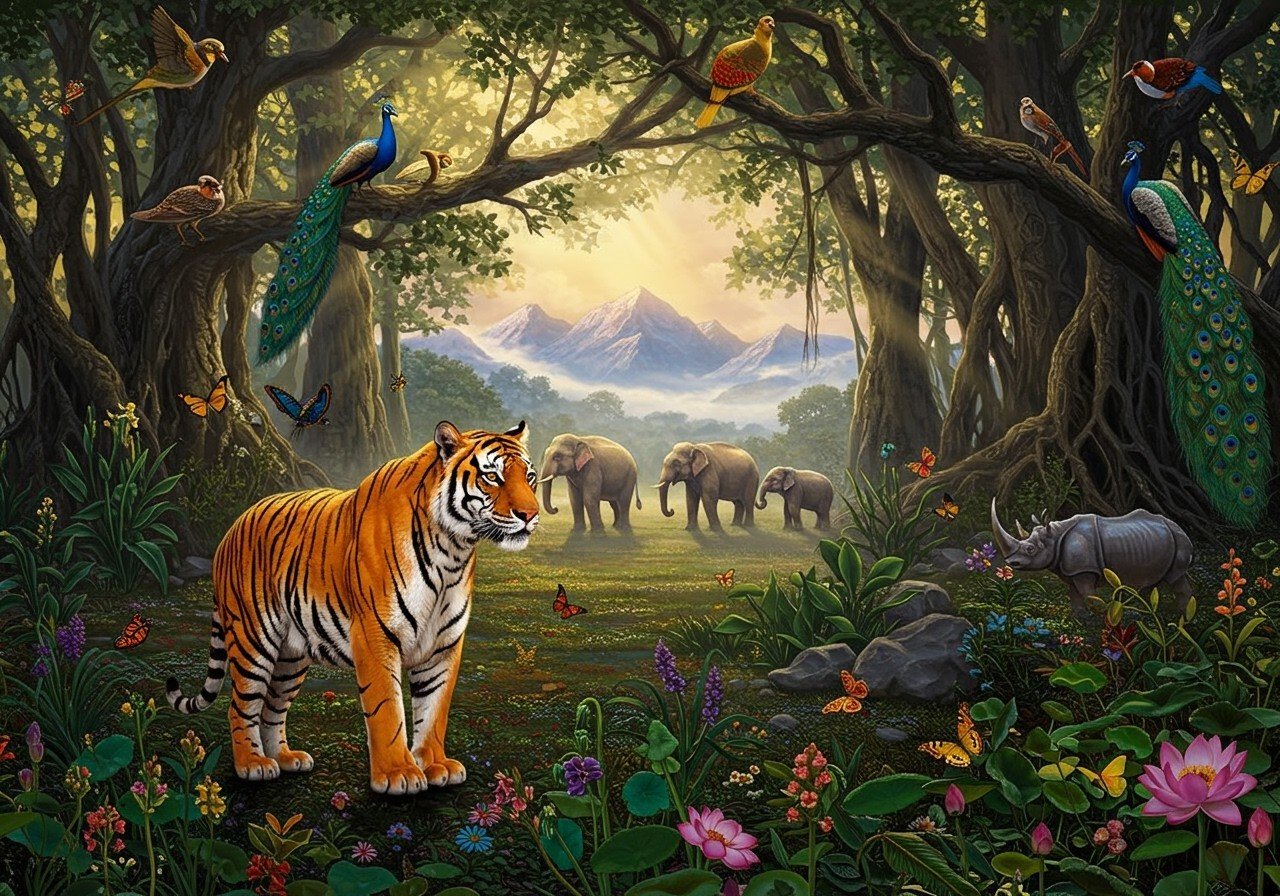
The Indian subcontinent, renowned for its diverse landscapes and ecosystems, harbors an extraordinary array of wildlife. Encompassing India, Pakistan, Bangladesh, Nepal, Bhutan, and Sri Lanka, this region sustains numerous species, many unique to this area. This article delves into the rich biodiversity of the Indian subcontinent, examining its distinctive flora and fauna, the conservation challenges they face, and the ongoing efforts to safeguard this natural heritage.
Geographical Diversity and Its Impact on Wildlife
The varied geography of the Indian subcontinent, from the towering Himalayas to the lush Western Ghats and the arid Thar Desert, creates diverse habitats supporting a wide range of species.
- The Himalayas: Home to the elusive snow leopard, red panda, and a variety of high-altitude birds such as the Himalayan monal. The Himalayas, with their varied altitudes and climatic conditions, create unique ecological niches for a wide range of specialized flora and fauna.
- The Western Ghats: A biodiversity hotspot, hosting species like the Nilgiri tahr, Malabar large-spotted civet, and numerous endemic snakes and amphibians. The Western Ghats are recognized as one of the world’s 36 biodiversity hotspots, harboring a high concentration of endemic species found nowhere else on Earth.
- The Thar Desert: Habitats for species adapted to arid conditions, including the Indian gazelle (chinkara) and the desert fox. The Thar Desert’s harsh environment has led to the evolution of unique adaptations in its flora and fauna, enabling them to survive in extreme conditions.
- The Sundarbans: The largest mangrove forest in the world, protecting the Bengal tiger, estuarine crocodile, and a variety of bird species. This unique ecosystem provides crucial breeding and nursery grounds for numerous aquatic species and plays a vital role in coastal protection.
- The Indo-Gangetic Plains: Rich in agricultural biodiversity and home to species such as the Indian rhinoceros and the Ganges river dolphin. The fertile plains support a high density of human population and agriculture, leading to significant human-wildlife interactions and conservation challenges.
- The Deccan Plateau: An arid region that supports species like the Indian wolf and the great Indian bustard. The Deccan Plateau’s unique geological formations and dry deciduous forests provide habitat for a variety of drought-tolerant species.
- Coastal and Marine Ecosystems: Including the diverse coral reefs of the Lakshadweep and Andaman Islands, which host a variety of marine life including dugongs and marine turtles. These coastal and marine ecosystems are vital for maintaining biodiversity and supporting the livelihoods of coastal communities.
Birds of the Indian Subcontinent
The Indian subcontinent is a birdwatcher’s paradise, with over 1,300 species of birds. Many are endemic or migratory.
- Diverse Avifauna: From the vibrant peafowl, India’s national bird, to the critically endangered great Indian bustard. The diverse habitats of the subcontinent support a wide array of bird species, ranging from tiny sunbirds to large raptors.
- Migratory Birds: The subcontinent serves as a critical stopover for migratory birds such as the Siberian crane and the bar-headed goose. Many migratory birds rely on the subcontinent’s wetlands and other habitats for resting and refueling during their long journeys.
Looking for traditional puja items that also support wildlife conservation? Explore our selection of eco-friendly products at Poojn.in.
Mammals of the Indian Subcontinent
Home to iconic species such as the Bengal tiger, the Indian subcontinent boasts a rich mammalian diversity.
- Big Cats: Including the Bengal tiger, Asiatic lion, and the elusive snow leopard. These apex predators play a crucial role in maintaining the balance of the ecosystem.
- Elephants: The Asian elephant, a keystone species, and their role in forest ecosystems. Elephants are essential for seed dispersal and maintaining forest structure, contributing significantly to biodiversity.
Enhance your puja experience with authentic and eco-friendly items from Poojn.in. Our collection includes copper vessels, natural fiber mats, and organic incense sticks.
Conservation Challenges and Efforts
The Indian subcontinent faces numerous conservation challenges but also has several successful initiatives aimed at preserving its biodiversity. India, a megadiverse country with three biodiversity hotspots, faces the challenge of balancing development with conservation.
- Habitat Destruction: Deforestation, urbanization, and agricultural expansion leading to habitat loss. The increasing human population and development pressures are resulting in significant habitat fragmentation and degradation.
- Human-Wildlife Conflict: Encounters between humans and wildlife, particularly in rural areas, and strategies to mitigate these conflicts. As human populations expand into wildlife habitats, conflicts over resources and space become increasingly common.
Support wildlife conservation by choosing sustainable puja products. Visit Poojn.in to find eco-friendly options for your traditional needs.
Conclusion
The wildlife and biodiversity of the Indian subcontinent are truly remarkable. From the Himalayas to the coasts, the region’s varied ecosystems support a wealth of life. However, these natural treasures are threatened. Habitat destruction, human-wildlife conflict, and climate change pose significant challenges. Fortunately, dedicated conservation efforts are underway, including national parks, wildlife sanctuaries, and community-led initiatives. By supporting these efforts and raising awareness, we can ensure future generations experience the wonders of this region’s biodiversity. Let’s work together to preserve this natural legacy.
For authentic puja items that respect tradition and the environment, visit Poojn.in.


